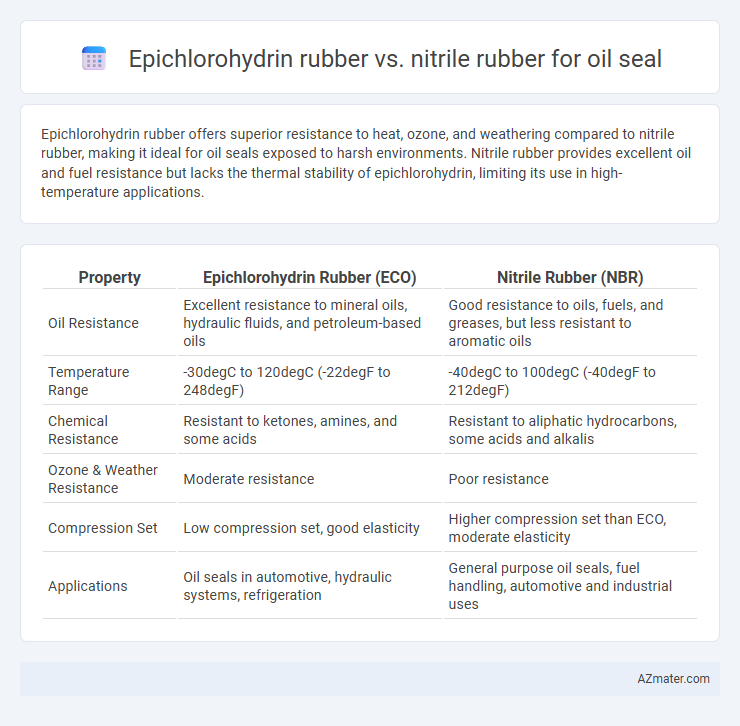Epichlorohydrin rubber offers superior resistance to heat, ozone, and weathering compared to nitrile rubber, making it ideal for oil seals exposed to harsh environments. Nitrile rubber provides excellent oil and fuel resistance but lacks the thermal stability of epichlorohydrin, limiting its use in high-temperature applications.
Table of Comparison
| Property | Epichlorohydrin Rubber (ECO) | Nitrile Rubber (NBR) |
|---|---|---|
| Oil Resistance | Excellent resistance to mineral oils, hydraulic fluids, and petroleum-based oils | Good resistance to oils, fuels, and greases, but less resistant to aromatic oils |
| Temperature Range | -30degC to 120degC (-22degF to 248degF) | -40degC to 100degC (-40degF to 212degF) |
| Chemical Resistance | Resistant to ketones, amines, and some acids | Resistant to aliphatic hydrocarbons, some acids and alkalis |
| Ozone & Weather Resistance | Moderate resistance | Poor resistance |
| Compression Set | Low compression set, good elasticity | Higher compression set than ECO, moderate elasticity |
| Applications | Oil seals in automotive, hydraulic systems, refrigeration | General purpose oil seals, fuel handling, automotive and industrial uses |
Overview of Epichlorohydrin Rubber and Nitrile Rubber
Epichlorohydrin rubber (ECO) offers excellent resistance to oil, heat, and weathering, making it suitable for oil seals exposed to harsh environments, with superior ozone and chemical resistance compared to nitrile rubber (NBR). Nitrile rubber is widely used for oil seals due to its strong oil and fuel resistance, good abrasion resistance, and cost-effectiveness, though it typically exhibits lower heat and ozone resistance than epichlorohydrin rubber. Both materials serve critical roles in sealing applications, with epichlorohydrin preferred for longer-lasting performance in extreme conditions and nitrile for general-purpose oil resistance.
Key Properties of Epichlorohydrin Rubber (ECO)
Epichlorohydrin rubber (ECO) offers excellent resistance to oils, ozone, and weathering, making it ideal for oil seal applications requiring durability in harsh environments. Its low gas permeability and good flexibility at low temperatures enhance sealing performance compared to nitrile rubber. High chemical resistance to polar solvents and superior heat aging properties further distinguish ECO as a premium choice for demanding oil seal seals over nitrile rubber.
Key Properties of Nitrile Rubber (NBR)
Nitrile rubber (NBR) exhibits excellent resistance to petroleum oils, fuels, and other hydrocarbons, making it ideal for oil seal applications requiring durability in harsh chemical environments. Its superior tensile strength, abrasion resistance, and elasticity outperform Epichlorohydrin rubber, particularly in maintaining sealing performance across a wide temperature range from -40degC to 120degC. The high resistance of NBR to swelling and chemical degradation ensures extended service life and reliability in automotive and industrial oil sealing systems.
Oil Resistance: Epichlorohydrin vs Nitrile
Epichlorohydrin rubber exhibits superior oil resistance compared to nitrile rubber, making it highly suitable for oil seals in environments with exposure to synthetic oils, brake fluids, and certain fuels. Nitrile rubber offers good oil resistance but tends to degrade faster when exposed to aromatic hydrocarbons and certain solvents found in machinery oils. Selecting epichlorohydrin rubber enhances seal longevity and performance in demanding oil application conditions, particularly in automotive and industrial uses.
Temperature Performance Comparison
Epichlorohydrin rubber (ECO) offers superior resistance to a wide temperature range, typically performing well from -40degC to 120degC, making it suitable for applications requiring moderate heat and cold resistance. Nitrile rubber (NBR), commonly used in oil seals, exhibits efficient temperature performance within -30degC to 100degC but tends to degrade faster under high-temperature exposure compared to ECO. The enhanced thermal stability of epichlorohydrin rubber makes it a preferred choice for oil seals exposed to fluctuating or elevated temperatures in automotive and industrial environments.
Chemical Compatibility and Environmental Resistance
Epichlorohydrin rubber offers superior chemical compatibility with polar solvents, ketones, and aliphatic hydrocarbons, making it highly effective for oil seals in fuel systems and automotive applications. Nitrile rubber excels in resistance to petroleum-based oils, fuels, and greases, providing robust performance in oil seal applications exposed to mineral oils and hydraulic fluids. Epichlorohydrin demonstrates better ozone, weather, and heat resistance, enhancing environmental durability compared to nitrile rubber, which tends to degrade faster under prolonged environmental exposure.
Mechanical and Physical Property Differences
Epichlorohydrin rubber (ECO) exhibits superior resistance to heat, ozone, and chemicals compared to nitrile rubber (NBR), making it ideal for oil seals exposed to harsh environments. Nitrile rubber offers excellent abrasion resistance and good compatibility with petroleum-based oils but has lower resistance to weathering and oxidation than epichlorohydrin. Mechanically, ECO provides better tensile strength and elongation at break, enhancing durability and sealing performance under dynamic conditions.
Long-Term Durability and Aging Characteristics
Epichlorohydrin rubber exhibits superior long-term durability and exceptional resistance to ozone, weathering, and aging compared to nitrile rubber, making it ideal for oil seals in harsh environments. Nitrile rubber offers good oil resistance and mechanical strength but tends to degrade faster when exposed to high temperatures and oxidative conditions. For applications demanding extended service life and reliable sealing performance under aging stress, epichlorohydrin rubber is the preferred choice.
Cost Considerations for Oil Seal Applications
Epichlorohydrin rubber offers moderate cost advantages in oil seal applications due to its balanced performance and material pricing, making it a cost-effective option for medium-duty sealing tasks. Nitrile rubber generally presents lower initial material costs but may lead to higher maintenance expenses in harsh oil environments because of its reduced resistance to ozone and heat. Choosing between Epichlorohydrin and Nitrile for oil seals depends on long-term cost efficiency, factoring durability, chemical resistance, and service life in the application's specific operating conditions.
Best Applications and Recommended Uses for Each Rubber
Epichlorohydrin rubber excels in oil seals for automotive air conditioning and refrigeration systems due to its superior resistance to ozone, weathering, and flex cracking in low-temperature environments. Nitrile rubber is preferred for oil seals in fuel systems, hydraulic oils, and lubricants because of its excellent oil and fuel resistance along with high tensile strength. Choosing Epichlorohydrin is ideal for seals exposed to harsh environmental conditions, while Nitrile rubber suits dynamic sealing in petroleum-based applications requiring durability against abrasion and wear.

Infographic: Epichlorohydrin rubber vs Nitrile rubber for Oil seal
 azmater.com
azmater.com